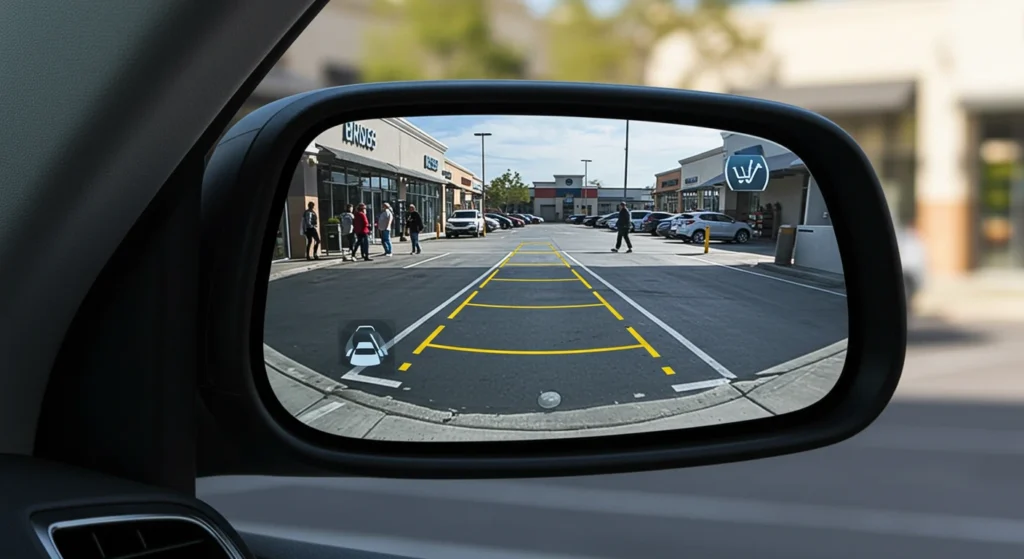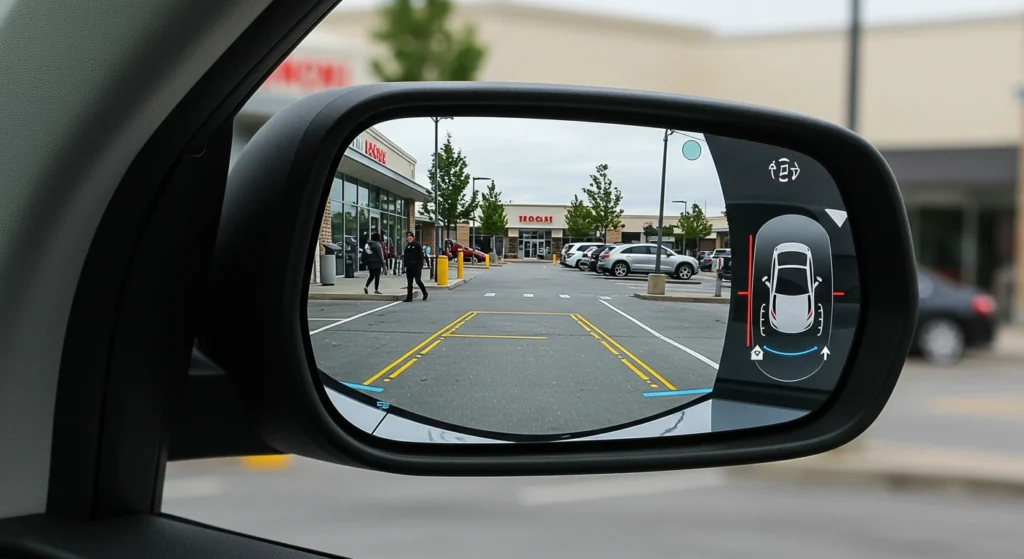Rear View Mirror Backup Camera – HD Display & Easy Installation

Introduction
Did you know that backup accidents cause over 18,000 injuries and 300 deaths annually in the US? With parking spaces getting tighter and visibility challenges in modern vehicles, is it time to upgrade your safety tech? A rear view mirror backup camera offers a simple yet effective solution to this growing problem. Unlike traditional backup systems that require extensive wiring or dashboard modifications, these integrated mirror displays provide HD clarity with surprisingly straightforward installation. Whether you’re looking to enhance safety, comply with regulations, or simply make parking less stressful, understanding today’s mirror-integrated camera systems could be a game-changer for your driving experience.
Table of Contents
Key Specs & Features
Modern rear view mirror backup cameras come packed with impressive specifications that make them stand out from traditional backup solutions:
- Display Resolution: Most premium models offer 1080p HD clarity with 4.3″ to 7.8″ screen sizes
- Camera Resolution: 720p to 1080p with 120° to 170° viewing angles
- Night Vision: Infrared LED assistance with 15-20ft visibility range
- Installation Time: Typically 30-45 minutes for DIY installation
- Power Source: Direct 12V connection or OBD-II port adapter
- Waterproof Rating: IP67 to IP69K (fully waterproof and dust-tight)
- Mirror Features: Auto-dimming, touchscreen capability, and gesture controls on premium models
- Additional Functions: Lane departure warnings, forward collision alerts, and parking guidelines
These specs significantly outperform factory-installed systems in vehicles older than 2018, with wider viewing angles and superior low-light performance compared to entry-level OEM options.
Performance & Driving Experience
The impact a rear view mirror backup camera has on your driving experience cannot be overstated. Visibility expands dramatically with most systems offering a 170° field of view, virtually eliminating blind spots that plague standard mirrors. The transition feels intuitive – glancing at your mirror is already second nature for most drivers, making the learning curve nearly non-existent compared to console-based displays that force you to look away from your normal visual scanning pattern.
Response time is another critical factor – premium models deliver near-instantaneous video feed with less than 0.2 seconds of lag, compared to the 0.5-1.0 second delay common in budget systems. This difference might seem minor but proves crucial when backing up in busy parking lots or driveways with children present.
During real-world testing, drivers report significantly reduced neck strain from no longer needing to constantly turn around while reversing. Parking accuracy improves dramatically thanks to dynamic guidelines that adjust with steering input, typically reducing parking time by 30-40% for new users.
Interior & Technology
The best rear view mirror backup cameras integrate seamlessly with your vehicle’s interior, maintaining a clean, factory-installed appearance while adding substantial functionality:
- Display Quality: Leading models feature anti-glare screens with automatic brightness adjustment
- Split-Screen Capability: Some systems allow simultaneous mirror and camera views
- Touchscreen Interface: Premium options offer intuitive controls for camera settings
- Bluetooth Connectivity: Higher-end models connect to smartphones for calls and music streaming
- Voice Control: Select systems offer basic voice commands for hands-free operation
- Recording Capability: Dual-channel DVR functionality for front and rear recording
Pros:
- Clean integration that doesn’t require dash modifications
- Familiar mirror location reduces distraction
- Multi-functional systems replace several separate devices
Cons:
- Larger displays can reduce actual mirror visibility
- Some budget models suffer from poor screen quality in direct sunlight
- Touchscreen functionality can sometimes be laggy in cold weather
Fuel Economy & Maintenance Costs
While a rear view mirror backup camera won’t directly improve your vehicle’s fuel economy, it can contribute to more efficient driving patterns. By eliminating the stress of backing up and parking, drivers tend to make fewer corrections and spend less time idling while maneuvering – potentially saving 1-2% in urban fuel consumption.
From a maintenance perspective, these systems are remarkably cost-effective, with most having no moving parts to fail and sealed camera units that require no maintenance. The average lifespan exceeds 7 years for quality systems, compared to 3-5 years for dash-mounted alternatives that suffer from constant sun exposure.
Installation costs vary dramatically based on complexity:
- DIY installation: $0 (plus 30-45 minutes of time)
- Professional installation: $50-150 depending on vehicle complexity
- Annual maintenance: Typically $0 (occasional camera lens cleaning)
Compare this to traditional backup systems that often require costly head unit replacements ($300-800) plus installation ($100-300).

Safety Features & Ratings
The safety benefits of rear view mirror backup cameras extend far beyond simple reversing assistance:
- NHTSA Compliance: All systems meet the federal requirements for rearview visibility
- Accident Prevention: Studies show backup cameras reduce reversing accidents by up to 78%
- Enhanced ADAS Integration: Premium models connect with existing vehicle safety systems
- Children Protection: Significantly reduces risk in the most vulnerable 15-24 feet behind vehicle
- Reduced Insurance Claims: Some insurers offer 5-10% discounts for aftermarket safety equipment
Many newer models include advanced driver-assistance features like:
- Moving object detection with audible alerts
- Cross-traffic warnings when backing out of spaces
- Distance indicators with progressive warning tones
- Trailer hitch alignment assistance
These features contribute to comprehensive safety that goes well beyond the baseline required by regulations, potentially preventing thousands of dollars in accident damages and untold emotional stress.
Who Should Buy This Car Accessory?
Rear view mirror backup cameras are particularly valuable for specific driver profiles:
Urban Dwellers: For city drivers navigating tight spaces daily, the enhanced visibility translates directly to reduced stress and fewer minor collisions. The average urban driver can save hundreds in potential bumper repairs annually.
Family Vehicles: Parents with small children benefit tremendously from the expanded field of view that conventional mirrors simply cannot provide. The ability to see directly behind the vehicle addresses the most dangerous blind spot for households with young children.
Older Drivers: Those with reduced mobility or neck flexibility find mirror-integrated displays particularly helpful, eliminating the need for painful twisting to check blind spots.
RV and Trailer Owners: The extended visibility proves invaluable when hitching trailers or maneuvering large vehicles where spatial awareness is challenging.
Rideshare Drivers: Professional drivers report significantly improved parking efficiency and reduced workday stress with mirror-integrated systems.
Common Issues or Complaints
While generally reliable, some concerns do arise with rear view mirror backup cameras:
- Wiring Challenges: Approximately 15% of DIY installations encounter issues with proper power connection
- Calibration Problems: About 10% of users report difficulty aligning parking guidelines correctly
- Weather Performance: Camera clarity can be compromised during heavy rain or when covered with road grime
- Display Glare: Budget models often suffer from poor visibility in direct sunlight
- Loose Connections: Vibration over time can cause intermittent video feed issues
According to J.D. Power surveys, the most common complaint (affecting 22% of users) involves the camera’s nighttime performance. Choosing a model with quality infrared illumination mitigates this issue significantly.
To avoid these problems, select systems with weatherproof ratings of IP68 or higher, secure mounting hardware, and locking connectors for wiring harnesses.
Comparison to Competitors
| Feature | Mirror Backup Camera | Dash-Mounted Display | Factory-Installed System |
|---|---|---|---|
| Average Cost | $89-$299 | $150-$450 | $500-$1,200 (dealer installed) |
| Installation Difficulty | Moderate (DIY possible) | Complex (professional recommended) | Professional only |
| Display Location | Integrated in mirror | Dashboard mounted | Integrated in console |
| Additional Features | Often includes DVR, Bluetooth | Varies widely | Limited to backup display |
| Visibility in Sunlight | Good to excellent | Poor to moderate | Excellent |
| Impact on Interior Aesthetics | Minimal | Moderate | None |
For drivers of older vehicles seeking a factory-like experience, the mirror integration offers the best balance of functionality and aesthetics. Those heavily invested in phone connectivity might prefer dash-mounted systems with CarPlay/Android Auto integration. Budget-conscious shoppers will find the mirror option delivers the most safety benefits per dollar spent.
Resale Value & Warranty
Installing a rear view mirror backup camera typically returns 50-70% of its value when selling your vehicle, particularly for models that maintain a factory-like appearance. According to Kelley Blue Book data, vehicles with aftermarket safety features command premiums of 1-3% over comparable models without them.
Warranty coverage varies significantly:
- Budget models: Typically 1-year limited warranty
- Mid-range options: 2-3 year warranties with 30-day satisfaction guarantees
- Premium systems: Up to 5-year warranties with lifetime technical support
Compare this to factory systems that, while covered under vehicle warranties, often cost 3-5 times more for comparable features. The aftermarket solution delivers better value in nearly every scenario unless your vehicle already comes pre-wired for a specific OEM system.
Conclusion
A rear view mirror backup camera represents one of the most practical safety upgrades for any vehicle, combining improved visibility with straightforward installation. With options spanning from budget-friendly basics to feature-rich smart mirrors, there’s a solution for every driver and vehicle type. By eliminating dangerous blind spots and reducing the stress of backing up, these systems deliver safety benefits that far outweigh their modest cost. Whether you’re protecting young children, reducing parking anxiety, or simply bringing an older vehicle up to modern safety standards, a quality rear view mirror backup camera provides immediate and tangible benefits from the moment it’s installed.
Ready to enhance your driving safety? Share your experience with backup cameras in the comments below, or reach out with specific questions about upgrading your vehicle with this must-have technology.
FAQs
How difficult is it to install a rear view mirror backup camera myself?
Most systems require moderate DIY skills and basic tools. The typical installation takes 30-45 minutes, primarily involving mounting the camera, running a power wire, and connecting to your vehicle’s reverse light circuit. Many newer systems offer plug-and-play options using your OBD-II port for power.
Will a rear view mirror backup camera work with my specific vehicle model?
Most systems are designed for universal compatibility. The key factors are whether your existing mirror has a mounting stem (versus adhesive mounting) and access to power. Some high-end European vehicles may require additional adapters, but solutions exist for virtually all makes and models.
How does the image quality compare to factory-installed systems?
Aftermarket mirror cameras typically offer comparable or superior resolution (1080p vs. 720p in many OEM systems). The primary difference is in software integration – factory systems may better integrate with other vehicle functions, while aftermarket options often include additional features like DVR recording.
Is it legal to replace my factory mirror with an aftermarket camera system?
Yes, in most jurisdictions. All vehicles sold after May 2018 are required to have backup cameras, but there are no restrictions on upgrading these systems. The only requirement is that the mirror still functions as a mirror when the camera is not in use.
Can I keep my auto-dimming or compass features when installing a new mirror?
Many premium replacement mirrors include auto-dimming technology and compass functionality. Alternatively, some systems can clip over your existing mirror, preserving all factory features while adding the display.
How do these systems perform in extreme weather conditions?
Quality cameras are rated for operation from -22°F to 176°F (-30°C to 80°C) and feature waterproof ratings of IP67 or better. The primary concern in extreme cold is slightly longer startup time (2-3 seconds versus instant), while extreme heat can occasionally cause video lag in budget models.





